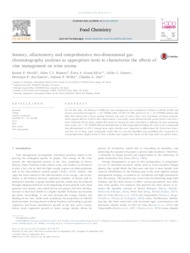Sensory, olfactometry and comprehensive two-dimension algas chromatography analyses as appropriate tools to characterize the effects of vine management on wine aroma.
Sensory, olfactometry and comprehensive two-dimension algas chromatography analyses as appropriate tools to characterize the effects of vine management on wine aroma.
Author(s): NICOLLI, K. P.; BIASOTO, A. C. T.; SOUZA-SILVA, E. A.; GUERRA, C. C.; SANTOS, H. P. dos; WELKE, J. E.; ZINI, C. A.
Summary: For the first time, the influence of different vine management was evaluated in relation to volatile profile and sensory perception through GC×GC/TOFMS, QDA, GC-FID, GC/MS, and GC-O.GC×GC/TOFMS analyses and QDA have shown that a larger spacing between vine rows (2 rather than 1 m),attachment of shoots upwards, and irrigation did not result in wine improvement. Conversely,wines elaborated with grapes from a vine with a lower bud load (20 per plant; sample M 1) stood out among the other procedures, rendering the most promising wine aroma.GC×GC/TOFMS allowed identification of 220 compounds including 26 aroma active compounds also distinguished by GC-O.
Publication year: 2018
Types of publication: Journal article
Unit: Embrapa Grape & Wine
Observation
Some of Embrapa's publications are published as ePub files. To read them, use or download one of the following free software options to your computer or mobile device. Android: Google Play Books; IOS: iBooks; Windows and Linux: Calibre.
Access other publications
Access the Agricultural Research Database (BDPA) to consult Embrapa's full library collection and records.
Visit Embrapa Bookstore to purchase books and other publications sold by Embrapa.

